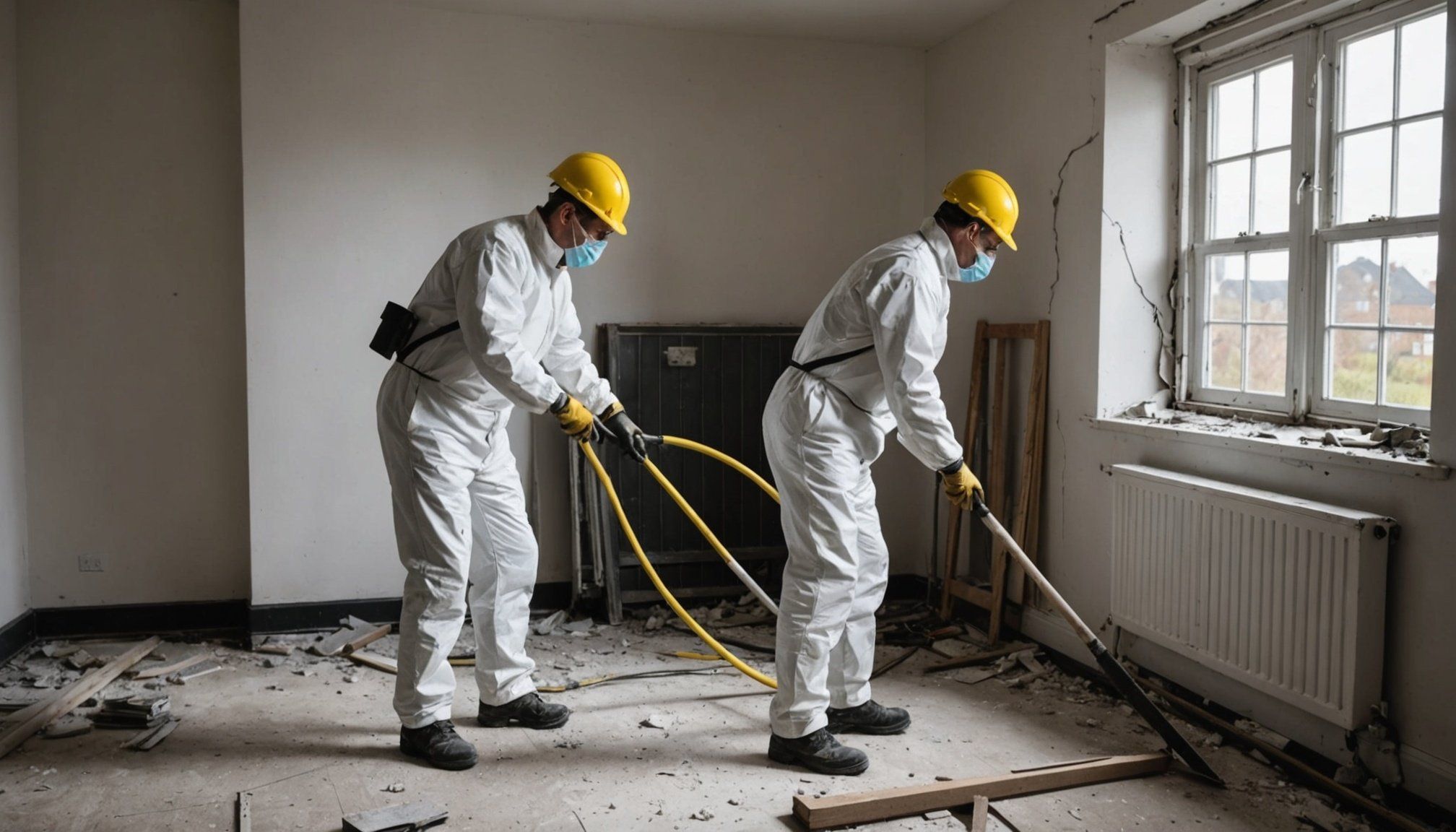Legal Guidelines for Asbestos Removal in the UK
Navigating the asbestos regulations in the UK requires a clear understanding of the legal framework set out in the Control of Asbestos Regulations 2012. These regulations form the backbone of compliance requirements for businesses undertaking asbestos removal, ensuring safety both for workers and the public.
Key aspects of the legislation include the necessity for risk assessments and the implementation of a robust management plan. These obligations ensure that any asbestos hazard is identified and controlled effectively, minimising exposure. Companies must ensure they are adhering to these legal obligations to avoid any potential civil or legal repercussions.
Have you seen this : Essential Tips for Constructing a Fire-Resistant Garden Shed in the Scenic Countryside of Wales
The Health and Safety Executive (HSE) serves a crucial function in the regulation and enforcement of asbestos removal practices. As the authoritative body, it provides guidance, monitors compliance, and can take enforcement action when regulations are breached.
Before commencing any asbestos removal project, it is essential to understand the necessary notifications and permits that must be secured. Specific projects might require notification to the HSE, and in certain cases, a licensed contractor must be used. This element of the regulations ensures a controlled and safe removal process, protecting both the environment and public health.
Also to see : Top Pollinator-Friendly Plants to Enliven Your Bristol City Centre Garden
Safety Equipment and Personal Protective Gear
When working with asbestos, safety equipment is non-negotiable. The specific types of personal protective equipment (PPE) required are pivotal in minimising health risks. These include disposable coveralls, gloves, and most critically, respiratory protection. A respirator equipped with a HEPA filter is essential for preventing inhalation of asbestos fibres.
The importance of wearing respiratory protection cannot be overstated. Asbestos fibres, when inhaled, can lead to severe respiratory illnesses, including asbestosis and lung cancer. Thus, properly fitted and maintained respirators are crucial for safety.
Moreover, the safe handling of tools and equipment designed specifically for asbestos work is integral. Tools must be non-electric or grounded to prevent sparking, and wet methods should be employed to minimise dust. All equipment should be regularly checked for defects and cleaned after each use to maintain its effectiveness.
These PPE requirements create a barrier between the worker and the hazardous material, reducing the risk of exposure. By complying with these measures, workers not only protect their health but also ensure a safer environment for everyone involved. Personal protective gear, combined with proper handling techniques, is the cornerstone of safe asbestos removal.
Step-by-Step Asbestos Removal Process
Understanding the asbestos removal process is crucial for ensuring safety and compliance. This step-by-step guide breaks down essential procedures for safe removal techniques and post-removal safety.
Preparation and Risk Assessment
Before commencing, a thorough risk assessment is paramount. Professionals will evaluate the site to identify the type and condition of asbestos present. This evaluation includes air quality checks and determining potential exposure risks. Proper site preparation involves erecting barriers, like polyethylene sheeting, to confine fibres. Personal protective equipment (PPE), such as respirators and coveralls, is mandatory for all in the vicinity.
Safe Removal Techniques
The core of the asbestos removal process lies in executing safe removal techniques. Wet methods are preferred, reducing airborne fibres by dampening materials before handling. Additionally, negative pressure units may be used to filter air during removal. Specialised tools and equipment ensure minimal disturbance of materials. Waste must be bagged and sealed in designated, clearly labelled containers for disposal.
Post-Removal Procedures
After removing asbestos, rigorous post-removal procedures ensure the area is safe. This includes HEPA vacuuming surfaces to eliminate any lingering fibres and conducting air quality tests to confirm successful decontamination. Proper disposal of asbestos waste, according to local regulations, completes the process, ensuring a safe environment for future use.
Health Risks of Asbestos Exposure
Asbestos exposure poses significant health risks, often manifesting long after initial contact. Asbestos fibres, when inhaled, can lodge in the lungs, resulting in serious conditions. The most concerning of these is asbestosis, a chronic lung disease marked by inflammation and scarring of lung tissue. This progressive condition leads to symptoms such as shortness of breath, persistent cough, and in severe cases, cardiac complications.
Mesothelioma, a rare cancer linked directly to asbestos exposure, is another grave consequence. It primarily affects the lining of the lungs but can also manifest in the abdomen and heart regions. Symptoms include chest pain, weight loss, and abdominal swelling. Early detection is rare due to its latent period, sometimes spanning decades.
Improper handling of asbestos increases the risk of developing lung cancer. While smoking intensifies this risk, asbestos is a significant factor itself. Even minimal exposure, if persistent, can elevate health risks substantially over time.
For individuals managing asbestos, understanding its long-term effects is crucial. Protective measures and regular health surveillance mitigate risks. By recognising symptoms early, one can seek appropriate medical intervention, potentially improving outcomes. Always prioritise safety to minimise exposure and ensure long-term health preservation.
Proper Disposal Methods for Asbestos Waste
Managing asbestos disposal safely is crucial to comply with legal requirements and protect public health. In the UK, adhering to stringent regulations ensures that asbestos waste management prevents hazardous exposure. This begins with identifying licensed disposal sites and facilities where safe disposal guidelines are strictly enforced.
Legal Requirements
The disposal of asbestos waste in the UK mandates following the updated Control of Asbestos Regulations 2012. These regulations require businesses to use registered carriers and licensed facilities for asbestos disposal. Non-compliance can result in severe penalties, exemplifying the significance of adhering to these legal standards.
Recommended Disposal Sites
Disposing of asbestos waste must occur at approved landfills and transfer stations. Facilities such as these are equipped to handle hazardous materials safely. The UK Environment Agency provides a comprehensive list of such permitted locations, which ensures that the waste is managed with care and precision.
Best Practices for Handling
When transporting asbestos, it is vital to use airtight containers to minimise the risk of fibre release. Proper labelling and documenting the waste also enhances the safety and traceability of the disposal process. Workers should always wear personal protective equipment (PPE) to maintain safety standards during the handling and disposal of asbestos materials.
Hiring Professional Asbestos Removal Services
When hiring asbestos contractors, ensuring the health and safety of your environment should be your top priority. Whether you’re dealing with a commercial property or a residential home, choosing certified removers is crucial for safe and effective asbestos management.
Begin by assessing the criteria for selecting a certified asbestos removal professional. Look for contractors who demonstrate a solid track record in asbestos management and disposal. Experience plays a key role here; seasoned professionals are more likely to handle complexities with ease.
Another essential aspect is verifying that the contractors possess relevant licenses and insurance. Not only do these credentials confirm their eligibility to perform asbestos removal legally, but they also offer you protection in case of any unforeseen incidents.
Before making a decision, it is wise to prepare a list of questions to ask potential contractors regarding their experience and methods. Inquire about how many years they have been in business, what specific techniques they employ for safety, and their approach to waste management, ensuring compliance with local regulations.
Finally, remember that professional services extend beyond mere execution. A reputable contractor will also offer guidance on future preventative measures, securing your peace of mind in maintaining a safe space.
Regulatory Compliance and Resources
Navigating the asbestos regulations landscape in the UK demands an understanding of key resources and compliance information. Staying informed through reliable sources is crucial to ensure safe asbestos removal and adherence to legal standards.
The UK government’s Health and Safety Executive (HSE) offers comprehensive guidance on these regulations. This includes detailed advice on safe asbestos handling, removal procedures, and management strategies. Their resources are readily accessible and regularly updated to reflect changes in laws and best practices, ensuring that both individuals and businesses remain compliant.
Local authorities also play a substantial role in disseminating additional compliance information. They often provide specific guidance tailored to regional needs, supplementing national standards with local insights and requirements. These resources can be invaluable for understanding the nuances of asbestos-related projects within specific jurisdictions.
Regularly consulting these official sources ensures that you are informed of any regulatory changes and new safety standards. Access to official government websites is essential, as they provide up-to-date, reliable, and comprehensive information on asbestos protocols in the UK. In this way, individuals and businesses can confidently align their practices with current legal requirements, maintaining safety and compliance at all times.
Understanding Asbestos and Its Risks
Asbestos is a naturally occurring mineral once widely used in the construction of UK homes due to its strength and heat resistance. It can be found in products such as roofing, insulation, and ceiling tiles. Identifying asbestos is crucial, particularly in older properties, to mitigate potential health risks. Visual identification can be challenging due to its microscopic fibres, so professional testing is often necessary.
Exposure to asbestos fibres poses significant health risks. Inhalation of these fibres can lead to serious respiratory conditions including asbestosis, lung cancer, and mesothelioma. Symptoms might not appear until years after exposure, highlighting the importance of early identification and management. Any renovation or demolition work in buildings containing asbestos must be handled with extreme caution to prevent fibre dispersion.
Legal implications are substantial in the UK when it comes to asbestos. The Control of Asbestos Regulations 2012 requires proper risk assessments and the safe removal of asbestos materials, especially during building renovations. Failing to comply with these regulations can lead to severe penalties. It’s imperative for homeowners and developers to engage licensed professionals for asbestos identification and removal to ensure safety and compliance with the law.
Legal Requirements for Asbestos Removal in the UK
In the UK, the Control of Asbestos Regulations 2012 establishes stringent guidelines for safe asbestos removal. These legal guidelines ensure that asbestos is managed effectively, protecting public health and safety. Key regulations include conducting a thorough risk assessment and creating a management plan before any work involving asbestos begins. Additionally, only licensed professionals should undertake such hazardous tasks, as working with asbestos without proper authorisation can lead to severe health risks.
Before any removal can commence, necessary notifications must be made. For instance, businesses must inform the Health and Safety Executive (HSE) about planned work involving asbestos at least 14 days in advance. This notification period allows authorities to ensure that all safety protocols are in place before the project starts.
Adherence to UK asbestos regulations is crucial, as penalties for non-compliance can be significant. Consequences include fines, legal action, and potential imprisonment for severe breaches that jeopardise public safety. Respecting these guidelines not only complies with the law but also showcases a commitment to responsible practices, fostering trust and safety in the workplace.
Understanding and following these regulations help ensure that asbestos removal is conducted legally and safely, minimising potential hazards.
Safety Protocols for Asbestos Management
Managing asbestos requires a stringent set of asbestos safety measures to minimise health risks. Before any renovations, conducting comprehensive risk assessments is a crucial step. This assessment helps identify areas where asbestos is present and determines the necessary precautions to implement during handling.
Safe handling of asbestos is paramount. It involves wearing appropriate personal protective equipment (PPE), such as masks and coveralls, which prevents inhalation of asbestos fibres. Ensuring the workspace is well-ventilated and employing wet removal techniques can significantly decrease fibre release, safeguarding everyone involved.
In the event of accidental exposure, having well-structured emergency procedures is vital. Respond quickly by:
- Exiting the contaminated area immediately.
- Securing the location to prevent further exposure.
- Seeking medical advice if symptoms, such as respiratory issues, develop.
Remember, asbestos fibres can pose serious health risks, so following established safety measures is essential. Maintaining a checklist ensures that no step is overlooked, thus enhancing safety and compliance with regulations. Adhering to these protocols not only protects health but also fosters a secure working environment.
Proper Techniques for Asbestos Removal
When dealing with asbestos removal, it is crucial to follow established best practices to ensure safety and compliance. Begin by identifying all areas containing asbestos, using a certified inspector if needed. Once confirmed, set up a controlled environment by sealing the area with plastic sheeting and restricting access.
Proceed with a step-by-step guide for safe asbestos removal:
- Wetting Down: Moistening materials to prevent fibres from becoming airborne.
- Careful Removal: Gently detaching the asbestos without breaking it into small pieces.
- Appropriate Disposal: Collecting and sealing asbestos waste in designated bags, clearly labelled for disposal.
Utilise the correct tools and methods to ensure effective removal. Wear personal protective equipment (PPE) like masks, goggles, and disposable coveralls. Use negative air pressure machines to prevent contamination outside the sealed zone.
Be aware of common mistakes to avoid. For instance, never use power tools on asbestos materials, as they can release fibres. Avoid dry sweeping, which can disturb and spread harmful particles.
By understanding and implementing these techniques and best practices, individuals can manage asbestos safely, minimising health risks and ensuring compliance with relevant regulations.
Personal Protective Equipment (PPE) Necessities
Before handling asbestos removal, crucial PPE measures protect both workers and surrounding occupants. Essential protective gear plays a vital role in preventing exposure to hazardous asbestos fibers.
Essential PPE for Safeguarding Workers and Occupants
Specific PPE is necessary when dealing with asbestos. Full-body coveralls, ideally disposable, create a barrier against fiber contact. Respirators equipped with HEPA filters ensure that the air workers breathe is safe from harmful particles. Eye protection and disposable gloves further minimise exposure risks, maintaining safety for both employees and nearby occupants.
Guidelines for Selecting Appropriate PPE
Selecting the right PPE involves considering the work environment and potential exposure levels. Always choose gear that meets established safety standards. The PPE should fit comfortably, allowing free movement while offering maximum protection. Discuss options with safety professionals to ensure the equipment’s suitability for the specific task.
Maintenance and Disposal of PPE After Use
Proper cleaning and disposal protocols are mandatory to contain any contamination. Single-use items should be placed in designated asbestos waste bags, while reusable gear must be thoroughly decontaminated per the guidelines. Employers should establish a routine maintenance program to inspect and replace PPE as required, ensuring ongoing protection and compliance.
Waste Disposal Methods for Asbestos
Understanding the legal guidelines for asbestos waste disposal in the UK is crucial to ensure compliance and safety. The Control of Asbestos Regulations 2012 outlines these guidelines, emphasising the need for asbestos to be securely packaged and clearly marked before transport. It is unlawful to dispose of asbestos in regular waste streams, and such actions can lead to significant penalties.
Safe transportation and disposal protocols involve using licensed contractors who follow strict measures. Asbestos waste should be double-bagged in heavy-duty plastic and labelled with cautionary markings. Vehicles used for transport must also be labelled appropriately to indicate the hazardous nature of the contents.
While recycling options for asbestos are limited due to its hazardous nature, some alternative disposal options exist. One method involves converting asbestos waste into less harmful materials through processes like thermal degradation or chemical treatments. These alternatives, however, require specialised facilities and are not widely available.
For individuals or businesses, the emphasis should be on hiring competent professionals who adhere to disposal guidelines. Always confirm that the service provider is registered with the Environment Agency and has a waste carrier’s license. Following these protocols reduces potential health risks and ensures the safe handling of asbestos waste.
Resources for Professional Asbestos Removal
Navigating asbestos removal requires caution and professional help. Here’s a guide to finding certified asbestos removal services.
Begin by verifying the credentials of potential contractors. It’s crucial to ensure they are certified and licensed, which confirms they follow safety regulations and have a deep understanding of asbestos risks. Look for contractors registered with official bodies, and check reviews or testimonials for a broader insight into their reputation.
While assessing contractors, ask pivotal questions. Inquire about their experience specific to asbestos removal and request references from past clients. Clarify the methods they use, ensuring they comply with industry standards and regulations. Equally important is discussing the estimated timeline and obtaining a comprehensive quote to avoid unexpected expenses.
Engaging professionals for complex situations is non-negotiable. Asbestos, when disturbed or improperly handled, poses significant health risks. Professionals possess the expertise, specialised equipment, and safety protocols to manage these dangers effectively. Do-it-yourself attempts can lead to incomplete removal and serious exposure issues.
In conclusion, finding the right asbestos removal services hinges on thorough vetting and asking the right questions. Their expertise not only ensures safety but also compliance with health standards critical to protecting your well-being.
Identifying Asbestos in Your Home
Identifying asbestos in your home, especially in older buildings, is crucial for maintaining a safe living environment. Older homes, particularly those built before the 1980s, are more likely to contain asbestos in materials like insulation, floor tiles, and roofing. Recognising signs such as damaged insulation or brittle floor tiles can hint at possible asbestos presence.
Conducting an asbestos inspection yourself requires careful attention to these areas. Start by examining suspicious materials that appear worn or damaged, as this can increase the risk of asbestos fibres being airborne. Use tools like plastic sheeting to contain any debris and avoid disturbing potential asbestos materials.
However, there are scenarios where it is imperative to contact professionals for asbestos testing. If you suspect significant exposure risks, hiring a qualified professional ensures precise results and safety. Experts will use specialised equipment and follow stringent safety protocols to sample and test materials accurately. They can provide a thorough home inspection, identifying all areas where asbestos might be present.
In conclusion, while you can start with a basic check yourself, professional asbestos testing and home inspection provide peace of mind by ensuring all risks are carefully assessed and managed, keeping your home environment safe.
Steps to Take if Asbestos is Found
Discovering asbestos in your home can be alarming, but knowing the right steps to take can mitigate risk. Upon an asbestos discovery, immediately stop any activities that might interfere with its fibres. Asbestos is most dangerous when disturbed, which releases tiny fibres into the air that can be inhaled.
Once you’ve halted activities, focus on assessing the situation to form an appropriate action plan. Engage a certified asbestos professional to conduct a thorough inspection and risk assessment. This assessment will determine the extent of the asbestos contamination and whether it poses any immediate danger to health.
Understanding your legal obligations is crucial. In many areas, homeowners are required to report the discovery to local authorities. This report may allow for guidance on the safest removal methods or how to contain the material effectively.
Legal documentation and professional assessment will aid in determining the appropriate remediation actions. This approach not only safeguards the health of everyone in the vicinity but also ensures compliance with residential regulations concerning hazardous materials. Taking the correct steps efficiently can alleviate concerns and prevent unnecessary exposure, creating a secure environment for all residents.











